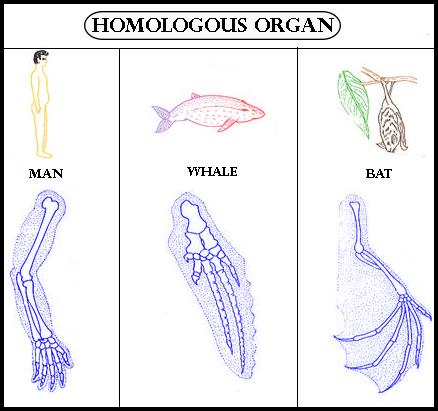
The study of homologous structures in mature organisms provides evidence for the evolutionary relationships among certain groups of organisms. Which field of study includes this evidence of evolution?
(a) Comparative cytology
(b) Biochemistry
(c) Geology
(d) Comparative anatomy
Answer
462.6k+ views
Hint: If a particular physical feature, such as a complex bone structure or a body plan, is shared by two or more animals, they may all have inherited this feature from a common ancestor. It is said that physical characteristics shared due to evolutionary history (a common ancestor) are homologous.
Complete answer:
- The study of similarities and differences in the anatomy of various animals is comparative anatomy. It is closely linked (the evolution of species) to evolutionary biology and phylogeny.
There are several different fields of biology where evidence for evolution comes from:
- Since a particular feature is present in a common ancestor (homologous structures) , organisms can share similar physical characteristics.

- The shared ancestry of life is represented by DNA and the genetic code. Comparisons of DNA will explain how related species are.
- Evolution and geological change are expressed by the global distribution of organisms and the distinctive characteristics of island species.
- The presence of now-extinct past organisms that are related to present- day organisms is recorded by fossils.
- In species with limited life cycles (e.g. pesticide- resistant insects) , we can directly observe small- scale evolution.
- Only in embryos can any homologous structures be seen. For instance, during early growth, all vertebrate embryos (including humans) have gill slits and a tail.
- In other species, species often have structures that are homologous to important structures but have lost their main ancestral function. Such structures, sometimes reduced in scale, are referred to as vestigial structures.
So, the correct answer is ‘(d) Comparative anatomy’.
Note:
- The area of research involving the analysis of similarities in the cells of various species is comparative cytology.
- The study of biomolecules such as DNA, proteins, and their pathways in biochemistry.
- The science of the Earth is geology.
Complete answer:
- The study of similarities and differences in the anatomy of various animals is comparative anatomy. It is closely linked (the evolution of species) to evolutionary biology and phylogeny.
There are several different fields of biology where evidence for evolution comes from:
- Since a particular feature is present in a common ancestor (homologous structures) , organisms can share similar physical characteristics.

- The shared ancestry of life is represented by DNA and the genetic code. Comparisons of DNA will explain how related species are.
- Evolution and geological change are expressed by the global distribution of organisms and the distinctive characteristics of island species.
- The presence of now-extinct past organisms that are related to present- day organisms is recorded by fossils.
- In species with limited life cycles (e.g. pesticide- resistant insects) , we can directly observe small- scale evolution.
- Only in embryos can any homologous structures be seen. For instance, during early growth, all vertebrate embryos (including humans) have gill slits and a tail.
- In other species, species often have structures that are homologous to important structures but have lost their main ancestral function. Such structures, sometimes reduced in scale, are referred to as vestigial structures.
So, the correct answer is ‘(d) Comparative anatomy’.
Note:
- The area of research involving the analysis of similarities in the cells of various species is comparative cytology.
- The study of biomolecules such as DNA, proteins, and their pathways in biochemistry.
- The science of the Earth is geology.
Recently Updated Pages
Master Class 12 Economics: Engaging Questions & Answers for Success

Master Class 12 Maths: Engaging Questions & Answers for Success

Master Class 12 Biology: Engaging Questions & Answers for Success

Master Class 12 Physics: Engaging Questions & Answers for Success

Master Class 12 Business Studies: Engaging Questions & Answers for Success

Master Class 12 English: Engaging Questions & Answers for Success

Trending doubts
Which are the Top 10 Largest Countries of the World?

Differentiate between homogeneous and heterogeneous class 12 chemistry CBSE

Draw a labelled sketch of the human eye class 12 physics CBSE

What is a transformer Explain the principle construction class 12 physics CBSE

What are the major means of transport Explain each class 12 social science CBSE

How much time does it take to bleed after eating p class 12 biology CBSE




